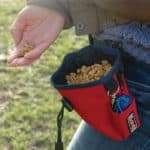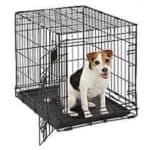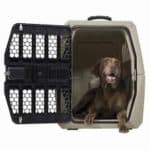CRATE TRAINING

CRATE TRAINING IS A MUST
Crate Training is a must for a well behaved and well trained puppy or dog. Crate Training is one of the first training steps for house breaking any puppy or older dog that you might have. I will go through the steps to successful crate training in this article, and be sure to watch the Crate Training Video that is in this article to show you the steps of crate training as well. If you find that you are struggling with crate training even after this article and accompanying video, please contact me at PHOENIX DOG TRAINING for personal one on one puppy training and dog training help in crate training your dog.
CRATE TRAINING BENEFITS
- CRATE TRAINING KEEPS YOUR PUPPY OR DOG SAFE
- CRATE TRAINING HELPS WITH POTTY TRAINING AND HOUSE BREAKING
- CRATE TRAINING PREVENTS DESTRUCTIVE BEHAVIOR
- CRATE TRAINING TEACHES PUPPIES AND DOGS SELF CONTROL
- CRATE TRAINING CAN GIVE YOU THE DOG OWNER A BREAK FROM HAVING TO SUPERVISE YOUR DOG OR PUPPY WHEN BUSY
There are many benefits to crate training a puppy or crate training an older dog. if you need to potty train a puppy or house break an older dog, the number one rule is to supervise or crate. dogs and puppies typically will not want to soil their crate and lay in urine or poo.
Crate Training prevents destructive behavior in that you always need to correct and redirect your dog or puppy for unwanted behaviors when you are not available to directly supervise your puppy or dogs behavior. This is very important when house breaking a puppy or dog.
If your puppy or dog gets away with going potty in the house without you seeing it or correcting it, your dog will learn that going potty in the house is ok because there is no consequence. you have to supervise or crate a dog so there are no missed opportunities to teach and correct your dog what not to do and teach appropriate house manners.
Because it is so important to watch, supervise or crate a puppy or dog with bad house manners, potty training and house breaking issues, how fast your dog learns is often determined on you crating your puppy or dog when you are not available to watch them.
The dog crate is never to be used as a punishment or time out. think of it as a baby crib. you place a baby in a crib or a play crib to keep the baby safe when you are not right their with it.
TOOLS YOU WILL NEED TO FOR CRATE TRAINING
A wire or metal crate or a plastic crate (size of crate should be as long as the puppy or dog is and not much larger.


10 STEPS TO CRATE TRAIN A PUPPY OR DOG IN JUST 5 MINUTES A DAY
STEP 1 Throw high value treats in the crate. The dog will follow the food into the crate associating the behavior of going in the crate with receiving a food reward. We want the dog to find the experience of going in the crate rewarding
STEP 2 After doing step 1 several times then add the next step of starting to “mark” the behavior of going in the crate with a clicker using the principles of clicker training . Make sure to click as the dog goes into the crate and before the dog gets the food reward you are throwing in the crate in step 1.
PUTTING STEP 1 AND STEP 2 TOGETHER MEANS
- Throw treat in the crate
- Dog or Puppy goes in crate
- Click to mark the behavior of the dog going in the crate
- Dog or Puppy eats the treat or food reward.
STEP 3 After you have practiced both steps 1 and step 2 together successfully then add the next step. Step 3 is to add a “cue” or “command” “Kennel” when the dog goes into the crate to get the treat. Be sure to say the “cue” or “command” of “Kennel” after you throw the treat in the crate. This should happen immediately after you throw the treat into the crate but before you click the clicker to mark the behavior of the dog entering the crate. In this step we are just labeling the behavior the dog is performing. We are not giving a command we are capturing the behavior of the dog going into the crate and adding a label to what the dog is doing. We don’t ask for the behavior yet with a command of “kennel,” we are just making the association of the word “kennel” with going in the crate several times.
PUTTING STEPS 1, 2, AND 3 ALL TOGETHER MEANS
- Throw treat in crate
- Say “kennel” as the dog first begins to move into the crate (remember we are not commanding “kennel” yet we are just saying the word “kennel” as the dog goes into the crate to follow and get the treat)
- Click and mark the behavior with the clicker of the dog going into the crate
- Dog eats the treat and is rewarded in the crate.
STEP 4 Begin to now ask for the behavior first by giving the cue or command “kennel” before you throw a treat into the crate. Use your treat hand to point into the crate rather than throwing the treat first, or pretend to throw the treat into the crate. If you spent enough time in steps 1,2, and 3, before moving on to step 4, your dog should now go into the crate when you give the command or cue “kennel” while you point the treat hand into the crate as if you had a treat and pretend you are pointing and throwing a treat into the crate. At this point in the training you are withholding the treat until the dog goes into the crate with the cue or command of “kennel” along with the hand pointing inside the crate. At this point you will reward the dog with the food only after you have given the cue or command of “kennel” and after the dog has gone into the crate and after you have marked that behavior with the clicker. The treat is given to the dog from your hand now after the click.
STEP 5 Close the crate door before marking the behavior for the dog. once the dog has gone into the crate on command or cue of ‘kennel” now close the door of the crate, then click and treat the dog. (Now the dog has to wait for the crate door to close before the click and treat happen.) Click and treat several times for the dog being in the crate with the crate door closed. You are now marking with the clicker and rewarding brief duration of the dog being in the crate for a brief time with the crate door closed. This is part of preventing Separation Anxiety for dogs and puppies when in a crate.
STEP 6 Teach the puppy or dog to wait in the crate even when the door is open. We are now opening and closing the crate door with the dog inside and teaching “kennel” as an implied stay. We are clicking and rewarding the dog with treats when the dog does not come out of the crate even if we open the crate door. If your dog or puppy tries to move out of the crate when you open the door, immediately close the crate door pushing the dog back into the crate while re- commanding “kennel.” When you open the crate door if the dog stays click and reward the implied stay in the crate.
STEP 7 Click and treat the dog or puppy for not coming out of the crate when the door is open. do this fast and often in the beginning. YOU WANT TO CLICK AND TREAT OFTEN WHEN THE DOG IS IN THE CRATE WITH THE DOOR OPEN. If the dog tries to get out of the crate right as you click, do not dive the treat. We don’t want to accidentally reward the behavior of coming out of the crate when we are trying to now teach this as an implied stay until released from the “kennel” command or cue. Remember if the dog tries to come out of the crate without permission, block the puppy or dog with the crate door from coming out, then try to slowly open the crate again.
STEP 8 Teach a release command or cue of “OK,” “Free,” or “Break.” When teaching the dog the release command or cue, you will give the cue or command you pick, in this case “OK’ as this is what I use in the above video tutorial for crate training. Often you will need to help your dog to understand what the release command or cue is and what it means by helping the dog out of the crate and then marking that behavior with the clicker and then reward. Practice only letting your puppy or dog exit the crate when hearing the command or cue of “OK’ signaling it is OK to come out of the crate.
STEP 9 Add distance and duration (time), step outside briefly. Come back in, click and reward for the duration and distance, also click and reward when you open the crate door and the puppy or dog stays in the crate. In addition to crate training you are teaching the implied stay and you are beginning the process of desensitizing any possible separation anxiety that some puppies and dogs experience with crate training and being left in a crate for a period of time. When first starting out, only leave the house for a minute or two. Gradually over 30 days increase your time away from 15-30 minutes. Add a minute or two a day more duration while training until you have successfully been able to train your puppy or dog to be in the crate calmly for 15-30 minutes. MOST DOGS THAT CAN BE TRAINED TO BE IN A CRATE FOR 15 MINUTES WITHOUT BEING UPSET DO NOT DEVELOP SEPARATION ANXIETY.
STEP 10 Keep your puppy or dog calm when you come home by practicing the dog or puppy staying in the crate until it is calm and here the release command or cue of “OK.” If your puppy or dog is more sensitive and prone to more anxiety when crated or left alone, begin to place your puppy’s or dog’s water bowl and food bowl in the crate along with your puppy or dog’s favorite toys. this will further help to prevent and desensitize any potential anxiety.
Remember Practice Makes Permanent! No one is Perfect! Practice this 5 minutes a day and your puppy or dog will be crate trained in no time. Review the Crate Training Video for further help.
Be sure to also check out our article on How to Potty Train a Puppy.
Please share this article
Happy Training



